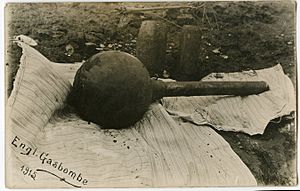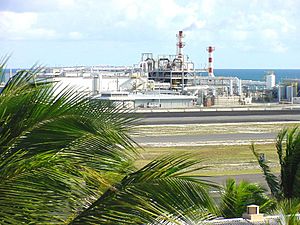Chemical weapon facts for kids
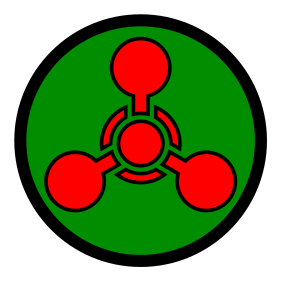 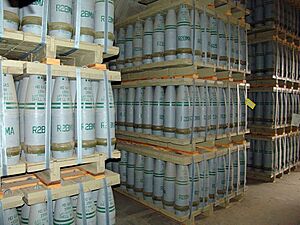
Pallets of 155 mm artillery shells containing "HD" (mustard gas) at Pueblo Depot Activity (PUDA) chemical weapons storage facility
|
|
| Blister agents | |
|---|---|
| Phosgene oxime | (CX) |
| Lewisite | (L) |
| Mustard gas (Yperite) | (HD) |
| Nitrogen mustard | (HN) |
| Nerve agents | |
| Tabun | (GA) |
| Sarin | (GB) |
| Soman | (GD) |
| Cyclosarin | (GF) |
| VX | (VX) |
| Blood agents | |
| Cyanogen chloride | (CK) |
| Hydrogen cyanide | (AC) |
| Choking agents | |
| Chloropicrin | (PS) |
| Phosgene | (CG) |
| Diphosgene | (DP) |
| Chlorine | (CI) |
| Vomiting agents | |
| Adamsite | (DM) |
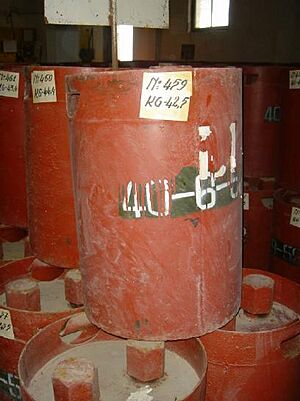 |
|
| Soviet chemical weapons canister from an Albanian stockpile | |
A chemical weapon (CW) is a special type of munition that uses harmful chemicals. These chemicals are designed to cause injury or death to people. The Organisation for the Prohibition of Chemical Weapons (OPCW) says a chemical weapon is any chemical meant to be a weapon. This includes chemicals that can cause death, injury, or irritation. Even the devices that deliver these chemicals are considered weapons.
Chemical weapons are part of what we call weapons of mass destruction (WMD). However, they are different from nuclear weapons, biological weapons, and radiological weapons. All these types of weapons can be used in war. They are often grouped under the military term NBC, which stands for Nuclear, Biological, and Chemical warfare.
Unlike conventional weapons, which use explosions or physical force, chemical weapons work through their chemical effects. They can spread as gas, liquid, or solid. This means they can easily harm people beyond the intended targets. Some modern examples include nerve gas, tear gas, and pepper spray.
Some chemical agents are very dangerous and can easily turn into gas. Many countries have stored these hazardous chemical weapons. The most dangerous ones are nerve agents (like GA, GB, GD, and VX) and blister agents (like mustard gas). These are liquids at normal temperatures but become gases when released. During World War I, gases like mustard gas and phosgene gas were widely used. They caused severe lung damage, blindness, and death.
During World War II, the Nazi regime used a chemical called Zyklon B to commit terrible mass killings. This happened in large gas chambers against Jews and other groups. This event, known as the Holocaust, led to the largest number of deaths from chemical weapons in history.
As of 2016, CS gas and pepper spray are still used by police for riot control. These are considered non-lethal weapons. The Chemical Weapons Convention (1993) is a worldwide agreement that bans making, storing, and using chemical weapons. However, some countries still have large amounts of these weapons. They often keep them as a precaution. Storing old chemical weapons is risky, as many are over 50 years old. The United States is now working to safely get rid of its chemical weapons.
Contents
How Chemical Weapons Are Used
Chemical warfare means using the harmful properties of chemicals as weapons. This is different from nuclear warfare and biological warfare. Together, these three make up NBC warfare. Chemical weapons are not like conventional weapons, which rely on explosions. Instead, chemical warfare depends on the unique effects of the chemical agent itself.
A deadly chemical agent is designed to hurt, disable, or kill an enemy. It can also prevent enemies from using a certain area. Defoliants are chemicals used to quickly kill plants. This helps to remove cover and hiding places for enemies. Chemical warfare can also target farms and animals to cause hunger. Chemical weapons can be delivered by remote-controlled containers, aircraft, or rockets. To stay safe from chemical weapons, people need special equipment, training, and ways to clean up contamination.
A Brief History of Chemical Weapons
Simple chemical weapons were used sometimes in ancient times and up to the Industrial Age. But the modern idea of chemical warfare began in the 1800s. Scientists and countries started suggesting the use of poisonous gases. Nations became so worried that they created international treaties to ban chemical weapons.
However, these bans did not stop the widespread use of chemical weapons in World War I. Both sides used chlorine gas and other gases to try and break the deadlock of trench warfare. While not always effective in the long run, these gases changed the war. Many people who were exposed did not die but suffered terrible injuries or disfigurements. About 1.3 million people were hurt by gas, including up to 260,000 civilians.
Between World War I and World War II, chemical weapons were used occasionally. European colonial forces sometimes used them to stop rebellions. Italy also used poison gas during its 1936 invasion of Ethiopia. In Nazi Germany, much research went into making new chemical weapons, like strong nerve agents.
However, chemical weapons were rarely used on battlefields in World War II. Both sides were ready to use them. But the Allied powers never did, and the Axis powers used them very little. The Nazis might not have used them because they lacked the technical ability or feared the Allies would use their own chemical weapons in return. The Allies did have plans for using chemical weapons if needed and stored large amounts.
Japanese forces used chemical weapons more often, but only against their Asian enemies. They also feared retaliation if they used them on Western powers. Poison gas was used against Chinese troops. However, the Nazis did use poison gas extensively against civilians in the Holocaust. Huge amounts of Zyklon B gas and carbon monoxide were used in the gas chambers of Nazi extermination camps. This led to about three million deaths, making it the deadliest use of poison gas in history.
After World War II, chemical weapons have been used in a limited but devastating way. About 100,000 Iranian soldiers were hurt by Iraqi chemical weapons during the Iran–Iraq War. Iraq also used mustard gas and nerve agents against its own people in the 1988 Halabja chemical attack. The Syrian government has used sarin, chlorine, and mustard gas in the Syrian civil war, often against civilians. Terrorist groups have also used chemical weapons, like in the Tokyo subway sarin attack.
International Rules Against Chemical Weapons
Before World War II
International law has forbidden the use of chemical weapons since 1899. The Hague Convention stated that using "poison and poisoned arms" was not allowed. It also said that countries should not use projectiles that spread "asphyxiating or harmful gases."
The Washington Naval Treaty, signed in 1922, tried to ban chemical warfare but failed because France did not agree. This failure led to more chemical weapons being stored.
The Geneva Protocol, signed in 1925, is an international agreement. It bans the use of chemical and biological weapons in wars between countries. It says that these weapons are "justly condemned by the general opinion of the civilised world." While it bans their use, it does not stop countries from making, storing, or moving these weapons. Later treaties were made to cover these missing parts.
Modern Agreements
The 1993 Chemical Weapons Convention (CWC) is the most recent international agreement against chemical weapons. Its full name is the Convention on the Prohibition of the Development, Production, Stockpiling and Use of Chemical Weapons and on their Destruction. This agreement makes it illegal to make, store, or use chemical weapons. The Organisation for the Prohibition of Chemical Weapons (OPCW) manages this agreement. The OPCW is an independent group based in The Hague.
The OPCW makes sure 192 countries follow the CWC. This includes 98% of the world's population. As of June 2016, 92% of chemical weapon stockpiles have been safely destroyed. The OPCW has done many inspections at chemical weapon sites and industrial sites. These inspections have taken place in 86 countries since 1997.
Countries with Chemical Weapon Stockpiles
In 1985, the United States Congress passed a law to get rid of its chemical weapons. This included over 3 million chemical weapons, totaling 31,000 tons. It was decided that safely getting rid of these weapons was much better than storing them. Between 1982 and 1992, the U.S. Army reported about 1,500 leaking chemical weapons. In 1993, a 100-gallon chemical spill of mustard agents happened at the Tooele Army Depot in Utah.
Chemicals in soil can be affected by many things, like temperature, acidity, and types of organisms. This makes it hard to know how safe old spill sites are. Spills of chemicals like sulfur mustards can remain harmful for decades.
How Chemical Weapons Are Stored

Chemical agents are stored in three main ways. First, they can be in self-contained munitions like projectiles, cartridges, mines, and rockets. These might also have explosive parts. Second, they can be in weapons delivered by aircraft. These two forms are ready for use. About 39% of the U.S. stockpile was in these ready-to-use forms.
The third way is as raw chemicals in large containers. The other 61% of the U.S. stockpile was stored this way. These chemicals are liquid at normal room temperature. However, some, like sulfur mustards, freeze at cooler temperatures. Mixing some chemicals can lower their freezing point even more.
Higher temperatures are a bigger worry because the risk of an explosion increases. A fire at one of these storage sites would be dangerous for the nearby community and the workers. The community would be at greater risk because they have less access to protective gear and special training. Studies have been done to see how to protect people during such emergencies.
Getting Rid of Chemical Weapons
After World War II, the Allies found large amounts of chemical weapons in Germany. They did not know how to get rid of them. So, the Allies dumped many of these chemical weapons into the Baltic Sea. This included 32,000 tons of chemical munitions and agents in the Bornholm Basin, and another 2,000 tons in the Gotland Basin.
Most of these weapons were dumped in simple wooden crates. This caused the chemicals to spread quickly. Dumping chemical weapons in the ocean was not only done in the Baltic Sea. Other areas with heavy contamination include the coasts of Europe, Japan, Russia, and the United States. These dumped weapons still pose risks to the environment and people's health. Chemicals from these sites have been found in ocean sediment. When chemical weapons are dumped, the agents spread widely. The long-term effects of this are not fully known, but they are negative.
In the Vietnam War (1955–1975), a chemical called Agent Orange was widely used by United States forces. The U.S. used Agent Orange as a "tactical herbicide" to destroy plants in Vietnam. This use of Agent Orange has had lasting impacts on the Vietnamese environment. It has also caused disease, stunted growth, and deformities in people.
United States Disposal Efforts
The chemical weapon stockpiles in the United States, kept for over 50 years, are now considered old and outdated. A law passed in 1985 (Public Law 99-145) told the Department of Defense (DOD) to get rid of these stockpiles. The DOD worked with the Federal Emergency Management Agency (FEMA) on this. This led to the Chemical Stockpile Disposal Program.
In the past, chemical weapons were buried, burned openly, or dumped in the ocean (called Operation CHASE). However, in 1969, the National Research Council (NRC) said that ocean dumping should stop. The Army then started studying ways to dispose of the weapons, including burning and chemical neutralization. In 1982, they chose incineration (burning) as the main method.
Construction of the Johnston Atoll Chemical Agent Disposal System (JACADS) began in 1985. This was a test facility using the chosen burning method. It was successful, but there were still concerns about operations on the U.S. mainland. Because of public worry about burning, Congress asked the Army in 1992 to look for safer and cheaper ways to dispose of the weapons. The Army had to report its findings by the end of 1993, including advice from the National Academy of Sciences.
In June 2007, the disposal program reached a big goal: 45% of the chemical weapon stockpile had been destroyed. The United States Army Chemical Materials Agency (CMA) gives regular updates to the public. On July 7, 2023, the program finished destroying all declared chemical weapons.
How Deadly Are Chemical Weapons?
Chemical weapons are designed to "deliberately use the toxic properties of chemical substances to inflict death." At the start of World War II, newspapers often reported that "entire regions of Europe" would become "lifeless wastelands." However, chemical weapons were not used as much as predicted.
An accidental chemical weapon release happened at the port of Bari. On December 2, 1943, a German attack damaged U.S. ships in the harbor. Mustard gas was released from their hulls, causing 628 injuries.
The U.S. Government was criticized for exposing American soldiers to chemical agents during tests. These tests were often done without the soldiers' permission or knowledge. Australian soldiers were also exposed in the "Brook Island trials." These trials were done by the British Government to see how chemical warfare might affect tropical areas.
Some chemical agents are made to change a person's mind, making them unable to do their job. These are called incapacitating agents. Their goal is not to kill, but to disable.
Unitary vs. Binary Weapons
Binary munitions contain two separate chemicals. These chemicals do not become harmful until they are mixed. This usually happens right before they are used in battle. In contrast, unitary weapons are chemical munitions that are already toxic in their current form. Most of the chemical weapon stockpiles are unitary, and much of it is stored in large containers.
See also
 In Spanish: Arma química para niños
In Spanish: Arma química para niños
- 1990 Chemical Weapons Accord
- CB military symbol
- General-purpose criterion
- List of chemical warfare agents
- Riot control


